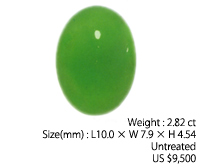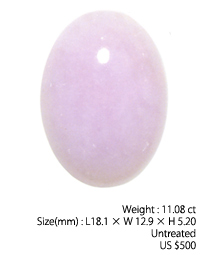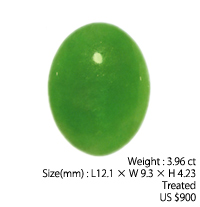COUNTRIES OF ORIGIN
AND VARIETIES
Currently, Myanmar is the primary source of jadeite, with Hong Kong being the main polishing center. Jadeite is also found in Guatemala, where it is said to have been used since 1500 B.C. It has also been mined since ancient times in the Itoi River area of Niigata in Japan, where material has been unearthed from remains dating back to the end of the early Jomon period (cieca 8000 B.C. to 200 A.D.).
|
 |
Green Jadeite
Usually polished as cabochons, in Japan this material is mostly used in rings. Simple references to jade or jadeite are indicative of this green jadeite. After polishing, the final manufacturing process is to apply wax to the surface to improve its luster. This does not significantly affect the quality of the jade.
|
|
Lavender Jadeite
Jadeite occurs in many colors. In addition to green, lavender is considered an attractive color. The lavender color will vary in tone and beauty grade. Beauty grade may be lowered by a color that is too bluish or too low in transparency or saturation, or by the presence of fractures. This may cause stones of the same size to differ in price by up to 100 times. However, lavender jadeite is often treated by dyeing, making it advisable to get a guarantee from a reputable store or confirmation by means of an identification report. Jadeite also occurs in colors such as orange, blue, brown, black, white, and gray. |
 |
 |
Treated Jadeite
Since the early 1980s, a treatment in which finished pieces of jadeite of poor transparency are impregnated with resins to improve their transparency has become widespread. In Hong Kong this material is called “B-jade” to distinguish it from untreated material. The value of such stones is less than one-tenth that of untreated material of equal appearance. It is difficult for anyone other than an expert to distinguish B-type material, so it is important to confirm whether jadeite is treated or not at the time of purchase. |
|
 |
JUDGING QUALITY
As with other gemstones, tone and beauty grade are the yardsticks used when ranking the quality of jade. Material with deep color and high transparency, a balanced oval shape, appropriate depth, and a fine polish (or simply put, a good overall appearance) qualifies for a beauty grade of S.
The deciding factor in judging quality is transparency. If placed on top of a printed page, exceptional material would be transparent to the point where one could read through a tablet-shaped stone.
Beauty grade S gem qualities are not only transparent, but they also have a very slightly bluish color. The difference from beauty grade A can be seen when compared under incandescent light. In jewelry-quality jade, the material either has a deep color (tone) with poor transparency, or a light color with high transparency. Material with tones of 6, 5, or 4 and a beauty grade of D are cut to thickness of about 1 millimeter, and plastic is applied to the bottom. These have problems with durability. When made into jewelry, they are often difficult to detect, and cheap imported jewelry is often made with a closed back to hide the fact that plastic has been applied. It is necessary to check the bottom of the jewelry as well as the top.
|
| |
|